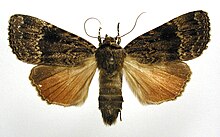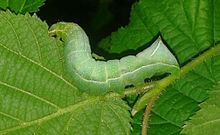Pyramid owl
| Pyramid owl | ||||||||||||
|---|---|---|---|---|---|---|---|---|---|---|---|---|

Pyramid owl ( Amphipyra pyramidea ) |
||||||||||||
| Systematics | ||||||||||||
|
||||||||||||
| Scientific name | ||||||||||||
| Amphipyra pyramidea | ||||||||||||
| ( Linnaeus , 1758) |
The copper underwing ( Amphipyra pyramidea ) is a butterfly ( moth ) from the family of cutworms (Noctuidae).
features
The moths reach a wingspan of 40 to 52 millimeters. They have gray-brown patterned forewings , on which the middle part is colored black. This is delimited towards the wing tip with a thin, partially dotted white band, towards the base of the wing it ends in the wing base color. In the upper part of this spot sits a small, white, black-core ring.
The caterpillars are about 42 millimeters long. They are blue-green in color and have many white spots spread over the body. On the back they are a little lighter in color, which is why they are difficult to see on the underside of leaves. The gradient from light to dark lets their contours run with the shadow on the sheet ("counter-shading"). At the level of the stigma there is a white, partially yellow side line, which is missing on segments three to five. At the end of the abdomen, from the tenth segment to the pusher , they have a large pyramid-shaped hump on which white lines run to the tip.
Similar species
The article on Svensson's pyramid owl ( Amphipyra berbera ) compares the differences between Amphipyra pyramidea vs. Amphipyra berbera listed.
Occurrence
The animals are widespread and common throughout Europe and the temperate zones of Asia . They live in forests , parks and gardens.
Way of life
The moths are dependent on heavy food intake for final maturation, which is also shown by the fact that they are greedy visitors to bait (e.g. a slightly fermented mixture of honey and dark beer). During the day they like to hide crawling in niches; behind the protruding bark of dead trees in the riparian forest you can sometimes find dozens of them. How they come together has yet to be researched.
Flight and caterpillar times
The pyramid owl forms a generation a year that flies from mid-July to early October. The caterpillars can be found from May to early July.
Food of the caterpillars
The caterpillars feed on various deciduous trees and shrubs, including goat willow ( Salix caprea ), European hazel ( Corylus avellana ), raspberry ( Rubus idaeus ), sycamore ( Acer pseudoplatanus ) and Common Ash ( Fraxinus excelsior ).
development
The females lay their purple eggs on the bark of the forage plants, where they survive the winter. They later turn to orange-red. The caterpillars feed on the underside of leaves, where they are well camouflaged due to their light-dark contrasts.
swell
Individual evidence
- ↑ a b c d e Heiko Bellmann : The new cosmos butterfly guide. Butterflies, caterpillars and forage plants. Franckh-Kosmos, Stuttgart 2003, ISBN 3-440-09330-1 , p. 268.
- ↑ a b Pyramid Owl. www.insektenbox.de, Wilfried Funk, accessed on September 27, 2006 .
- ^ Butterflies in Germany, online http://www.schmetterlinge-deutschlands.de/start.php (accessed on September 22, 2006)
literature
- Günter Ebert (Hrsg.): The Butterflies of Baden-Württemberg Volume 6, Nachtfalter IV. Ulmer Verlag Stuttgart 1997 (Eulen (Noctuidae) 2nd part), ISBN 3-8001-3482-9
- Karl Cleve: "The approach of the night butterflies to the light and to the bait", Entomologische Zeitschrift, 81.Jg.Nr12,1971, Alfred Kernen Verlag Stuttgart.
- Ernst Urbahn: Amphipyra pyramedea and Amphipyra berbera - two indistinguishable native noctuids. Entomological News, 1968, Volume 12
Web links
- www.lepiforum.de Taxonomy and photos
- www.schmetterling-raupe.de
- Amphipyra pyramidea at Fauna Europaea
- Ian Kimber: Guide to the moths of Great Britain and Ireland (English)
- Moths and Butterflies of Europe and North Africa (English)

